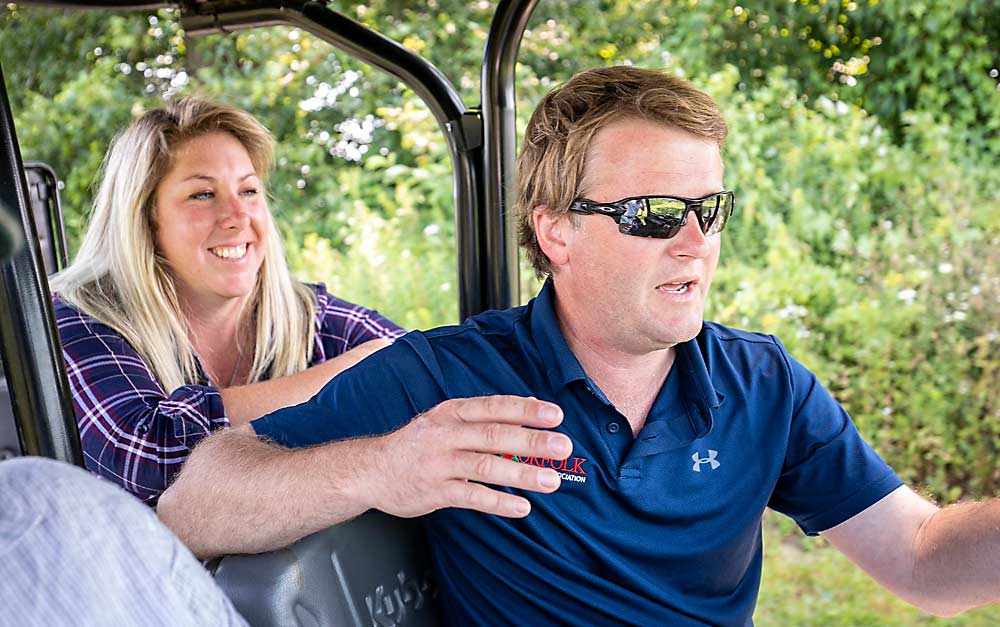
Hayden Dooney grew up on a family farm in New Zealand, but now he and his wife, Amanda Dooney, are building their own farm on the other side of the planet, in Norfolk County, Ontario, near where Amanda grew up on a cash crop farm.. A strong business background, support from the community and experienced farmworkers helped them hit the ground running.
They bought their first orchard in 2019, when the grower who owned the 45-acre orchard next to their home decided to retire and asked if they were interested in the property. They jumped at the chance to farm, in addition to his job as the general manager of the Norfolk Fruit Growers’ Association, NFGA, and her business organizing winery and craft brewery tours. Those day jobs helped when it came to securing the loans to buy and operate the orchards, he said.
“It’s hard to make a living on 45 acres, but between his role with the Norfolk Fruit Growers’ and my business, we can make a go of it,” Amanda said when the Good Fruit Grower visited last year. The first year owning the farm, there was a lot to learn, but they learned that they loved the work, she said. “It’s like having a baby for the first time.”
They christened it Suncrest Orchards.
And like a baby, their farm is growing fast. They bought a second orchard last winter, doubling their acreage, and aim to expand to about 150 acres in the next few years so that there’s enough scale to gain efficiencies and make an income from the orchard operations, Hayden said.
The Dooneys’ ambitious plans stand out in a region that has seen significant retirements and consolidation over the years, said Marshall Schuyler, president of the NFGA who, along with his sons, runs the largest orchard business in the area.
Hayden’s financial savvy helped him seize the opportunity presented by other growers exiting the business, Schuyler said. That’s good, because it’s important to the success of NFGA’s packing and storage business to continue to have enough apples grown in the region to supply it.
“It will be immensely satisfying to see him” grow his business, Schuyler said, adding that some flexibility from NFGA helps Dooney juggle his day job and the farm. “Hayden is the kind of guy who doesn’t need any help, but he’s the kind of guy you don’t mind helping.”
For his part, Hayden said the support from the Schuylers and others in the NFGA community has been invaluable. He was able to purchase the second orchard after the Schuylers acquired the assets of a major area grower who retired.
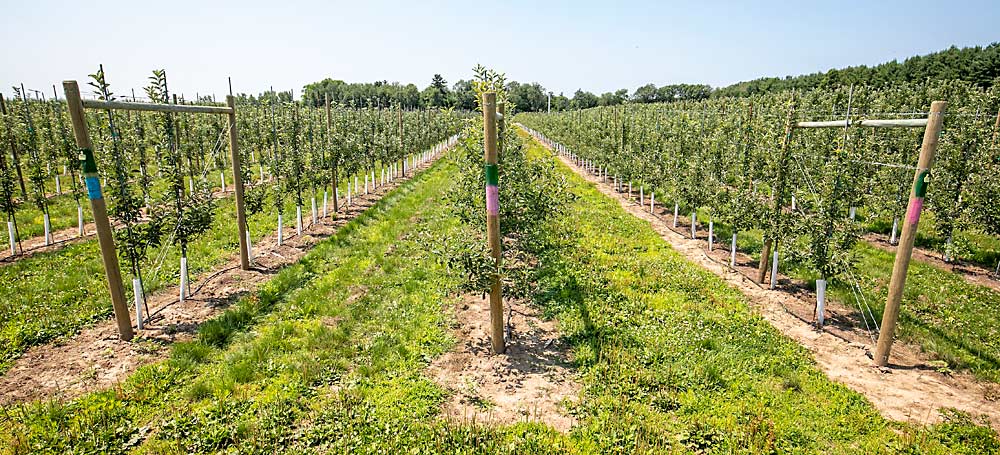
In addition to a 40-acre orchard block planted in a new, high-density system, Schuyler agreed that Dooney could pick up the contracts for some of the longtime guest workers who had worked on the new property.
“He needs to have capable and competent people,” Schuyler said.
The new property, 20 minutes from their home farm, means the crew has to look out for themselves more, Hayden said.
“If we hadn’t had a seasoned crew, that would have been a lot harder,” he said. “We’ve got a couple older gentlemen on the workforce; they’ve got some really good experience and they know how to operate efficiently.”
Tapping into the crew’s experience and supporting them has been a big component of their success so far — several are assigned responsibilities for different aspects of the operation, such as irrigation and equipment. Last winter, he invested in handheld electric pruners to reduce the strain of the work, and it’s also boosted their efficiency by 25 percent, he said.
With the first farm purchase, they renewed the contracts with two guest workers who had been with their neighbors every season for years and now feel like part of the family, Amanda said. She runs the payroll, bookkeeping, food safety audits and generally serves as “farm mom,” she said, picking up whatever needs to be done. Their two kids, ages 12 and 14, also discovered this year that they enjoy helping out in the orchards, she said. Conner, 14, got his first paychecks for thinning with the crew this summer — that helped.
When they expanded and needed to contract more guest workers, they sought recommendations from their two longtime workers, who knew many of the guys at the other farm. That set the stage for a cohesive crew of five, which paid off in the spring when the coronavirus limited everyone’s ability to socialize off the farm, she said.
Another wave of workers was supposed to arrive just before harvest, but consulate delays, plus the two-week quarantine required for everyone entering Canada, made it impossible for the guest workers to arrive from Jamaica in time, Hayden said. After a brief period of panic, he and other Norfolk growers connected with stone fruit growers from the Niagara area, who were wrapping up harvest, and transferred contracts for some of their guest workers willing to stay on for apple harvest.
After everything 2020 has thrown at them, including frost, hail and a pandemic, “it would have been pretty crushing not to be able to harvest,” Hayden said.
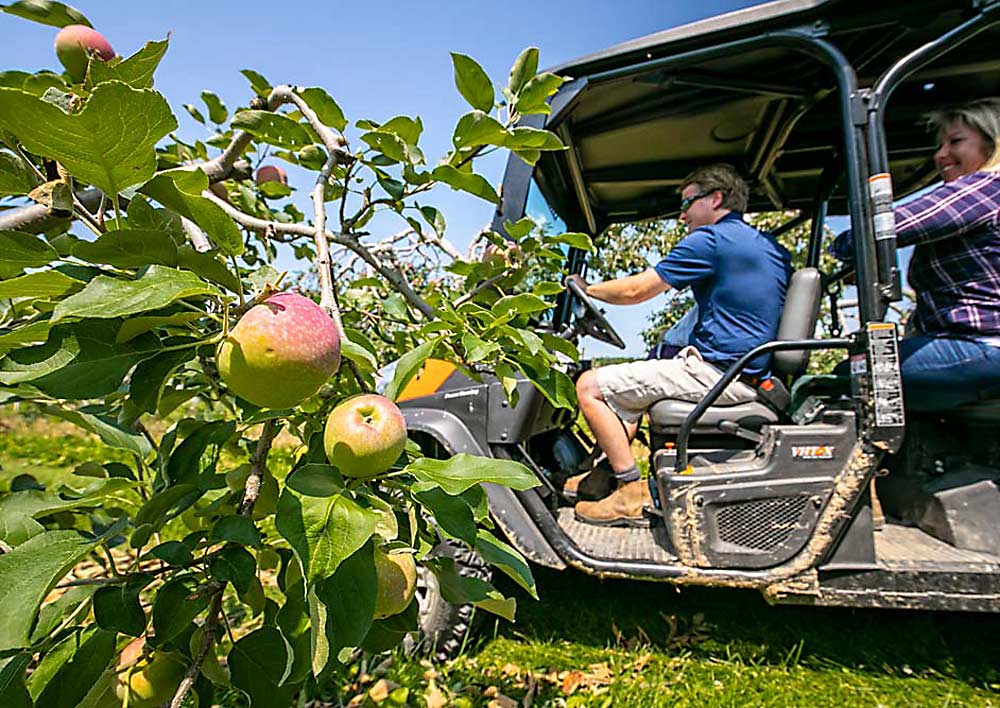
Getting to know their farm
“We’re very lucky because we had a chance to buy a turnkey farm,” Hayden said. Their varieties include Gala, Ambrosia, Honeycrisp, Sunrise, Ginger Gold, Paula Red and Golden Delicious, including 16 acres of new tall spindle plantings of Honeycrisp and Ambrosia. The former owners even gave him some tips on how to thin each block the first spring.
In contrast to those modern plantings, they also continue to crop some of the oldest trees in Norfolk County — weeping Paula Reds on standard roots that are over 60 years old and look like a real pain to prune.
“Everyone will tell you this is not the orchard you should be growing, but it’s still paying the bills,” he said. It produces an impressive 70 bins per acre and, since it’s a summer apple, there are no storage costs to cut into returns. He’ll keep them until they start costing more to maintain than they return.
Thinking about the bottom line first is Hayden’s standard approach. He credits his work at NFGA for helping him understand the key performance indicators to base his business on. Growers tend to look at returns per bin, he said, but that doesn’t actually tell you how your orchard is performing.
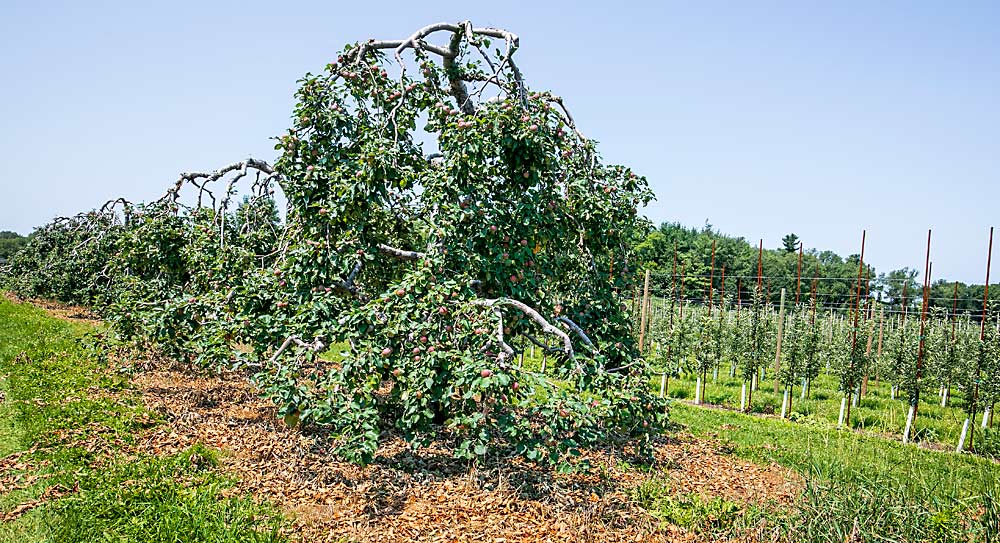
“We’ve got a system at NFGA that takes the information out of accounting and puts it alongside acreage” in the online portal, to see how each orchard is performing, he said. “You need fruit packing out and returns per acre.”
The act of making a business plan and spelling out the cost analysis, to work with their banker, also laid the framework for their goals for the farm and made sure it is financially feasible, he said. He and Amanda want to put in the sweat equity now to build a successful business that will someday fund their retirement.
“There’s not necessarily a right way and a wrong way to farm. You’ve got to take as much information as you can and then run the numbers and decide what works for your farm,” he said. “You don’t have to have the prettiest operation; you have to have the most profitable.”
This year, along with the challenge of adapting to the pandemic and taking on the second new farm in two years, they were hit hard by frost in early May. Despite several sleepless nights, the home farm lost about 50 percent of its crop.
A little bit of their fruit was picked by tourists who wanted to add a real farm experience to their fall cider and beer tours organized by Amanda’s company, Ride the Bine.
“This year more than ever before, people are really craving that outdoor farm experience. They want wide open spaces, fresh air, and they want to get in touch with their food sources,” she said.
A lot of people don’t even realize that every apple has to be picked by hand, Hayden added. That’s why it’s important to him to invite the tours to the farm, even if the apple sales are negligible in the scheme of things. “Farmers need people to understand what we do,” he said.
—by Kate Prengaman

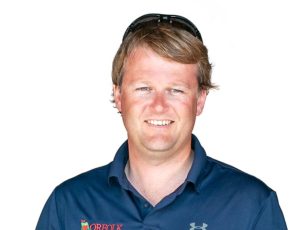





Leave A Comment